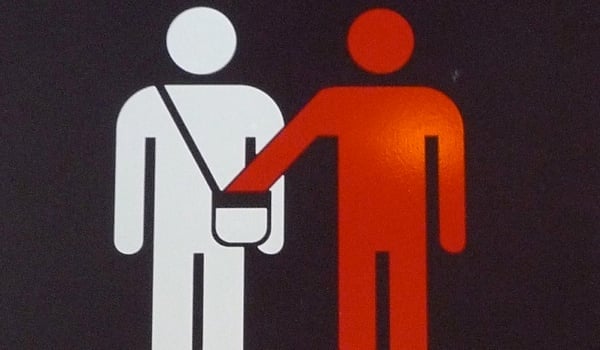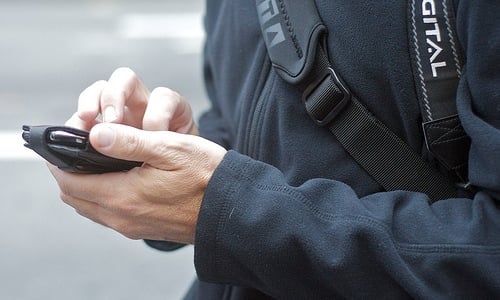What to do if your iPhone gets stolen—and how to prevent iPhone theft
Posted on
by
Lysa Myers

See also our newer article on how to enable Stolen Device Protection for iPhone.
Theft is a lame and unfortunate risk of living in close proximity to other humans. In the case of iPhones, it’s a growing problem. But there are things you can do to make the theft of your device a less terrible experience and to minimize the possibility of strangers accessing your accounts or your personal data. Some of these are actions you can (and should) take while your phone is still in your safe care, while the rest are things you should do to keep from singing the blues after your device has been taken from you.
“I Will Not Let You Go“

While your iPhone is still safe and warm in your own two hands, you can do a few things to help keep your device with you always and forever (well, at least until it comes time to upgrade with the newest version!).
Be Aware of Your Surroundings
We have probably all had that awkward moment when we were texting while walking and then ran into a wall or tripped on a curb. This isn’t just risky to our foreheads and our pride. Thieves can and do use this inattention as an opportunity to sneak up on you, especially in uncrowded areas.
Keep Your Phone Somewhere Secure
Pick-pockets like an easy target. Keeping your phone in a pocket of your jeans or on the outside of your purse is not a great idea, especially if you’re in a heavily crowded area. If you can keep your phone hidden and close to your body, it is much less likely to be nabbed.
Enable the Passcode Lock
It seems like there’s always some new flaw that will allow someone to get past the passcode lock if they steal your phone. But the odds are good the thief may not know the magic sequence that works on your particular phone (and they may lack the dexterity of a concert pianist that’s required for some of the crazy iterations!).
Install a Device-Finder App
It’s a good idea to turn on “Find My iPhone” or a similar device-finding app in case of theft. There are also a variety of apps out there that complement or go beyond the functionality of Apple’s offering that can help you recover your phone.
Create a Dummy Account
If you do have a device-finder app installed, in order to lure the thief in so the Device-Finder can do its more advanced actions, you will want to create a dummy account with no admin privileges and no password.
Encrypt Your Data
There are apps out there that will let you encrypt text messages, photos, and notes. If you really want to keep your data from prying eyes, you may want to invest in one.
Disallow Unauthorized Changes
To help keep a thief from undoing all your hard work here, you’ll want to make a couple more changes. Go to the Settings of your device and look in General->Restrictions. If you’ve not implemented any restrictions before, it will ask you to create a password. Once you’ve done that, look under the “Allow” section for ”Deleting Apps” and switch it to Off. When you’re finished that, find the “Allow Changes” section (also under Restrictions) and select “Accounts” to choose “Don’t Allow Changes.”
Perform Regular Backups
You’ll be a lot less reluctant to throw the kill switch and remotely wipe your data if you know you can restore it at a moment’s notice. This can give you a lot of peace of mind knowing a thief isn’t taking the only copy of important data or precious mementos.
“I’ve Got Tears in My Ears“

Oh, the woe of losing your device! Once you dry those tears, what now? What can you do to try to get your device back or keep a thief from getting their grubby mitts all over your digital life?
If It’s a Work Phone, Notify Your IT Person
There may be rules in your company about what to do in case of theft, which will almost certainly involve notifying someone if your phone has been lost or stolen. If there is sensitive company data on your phone, they may be able to block access.
Call Your Cell Phone Company
You don’t want to be on the hook for any fraudulent calls or purchases made on your phone. The phone company may require a police report, but it’s best to get the ball rolling as quickly as possible so you can avoid extra charges.
File a Police Report
Anything you want to do from this point forward will be best accomplished with a police report in place. So go to the nearest law enforcement office and document the theft. Your cell phone company may require it and your insurance will definitely require it. And if you get information from a Device-Finder app, the police will be better able to help you recover it.
Track Your Device
Here’s where the Device-Finder apps really earn their keep. Fire ‘em up and gather some data. If you didn’t already install one, all hope is not lost. There is a little trick using Dropbox that still might help you determine the device’s IP so you can try to locate it. Once you get that data, bring it to the local police. They’re trained to deal with folks breaking the law who could potentially get violent — you don’t want to try and confront the perpetrator yourself and risk getting injured over a phone.
Change Your Passwords
Whether or not you get your phone back after all that, you’re gonna want to play it safe and change your passwords. It’s hard to say if the thief will have successfully gotten into your phone and any accounts that your phone has access to, so change your passwords (including email accounts, social networking profiles, and any other online services) as an extra security measure.
Wipe Your Data
How sensitive the data on your phone is (and how recently you’ve performed a backup!) will decide where in the process this step comes. You may want to do this immediately, but you’ll at least want to do it as a last resort if you don’t manage to get your phone back.
Call Your Insurance Company
Assuming you have insurance on your phone, you’re going to want to replace your device as quickly as possible so you don’t have to live without it. If you eventually manage to recover your phone, that’s great, but don’t wait around in hopes of recovering your old device before finally caving and contacting your insurance company. File a claim as soon as you notice your phone is gone so you’ll have a replacement device as quickly as possible. Your phone may never be recovered, so the sooner you get the ball rolling with the insurance company, the better.
Notify Your Contacts
You don’t want people to worry that you’ve fallen off the face of the earth, or to be tricked into sending money to get you out of trouble in some remote locale! Drop your contacts a note to let them know to be on the lookout for strange communications that may not be from you.
There’s no guaranteeing you will never lose your device, or (more importantly!) the data on it, but with a little preparation and a cool head you can minimize the pain and get back on track.
How can I learn more?
Each week on the Intego Mac Podcast, Intego’s Mac security experts discuss the latest Apple news, security, and privacy stories, and offer practical advice on getting the most out of your Apple devices. Be sure to follow the podcast to make sure you don’t miss any episodes.
You can also subscribe to our e-mail newsletter and keep an eye here on The Mac Security Blog for the latest Apple security and privacy news. And don’t forget to follow Intego on your favorite social media channels: ![]()
![]()
![]()
![]()
![]()
![]()
![]()
Photo credits: pickpocket by Dunk (CC BY 2.0); holding iPhone by Steve Rhodes (CC BY-NC-ND 2.0); crying by Anil Kumar (CC BY-ND 2.0).
